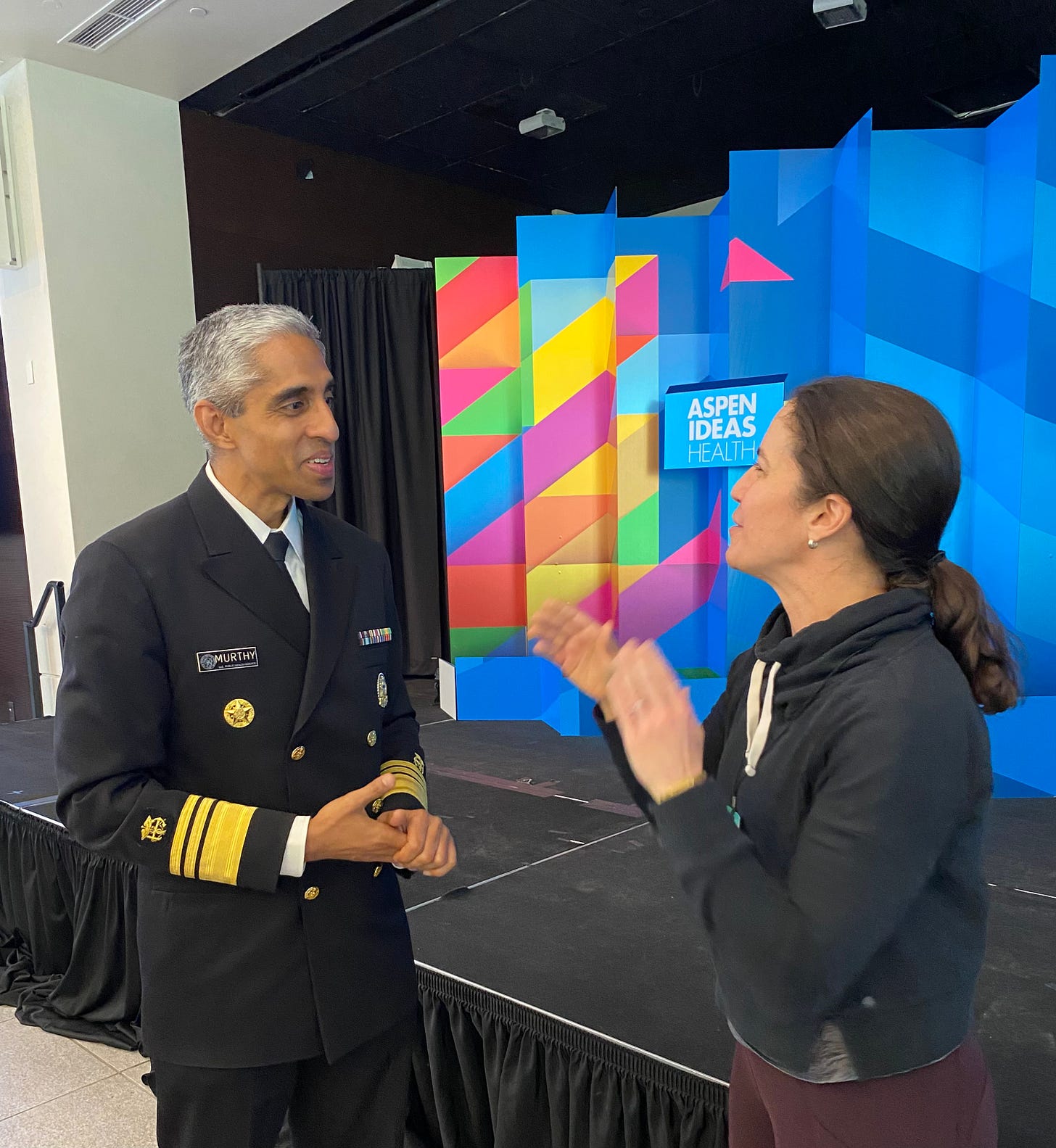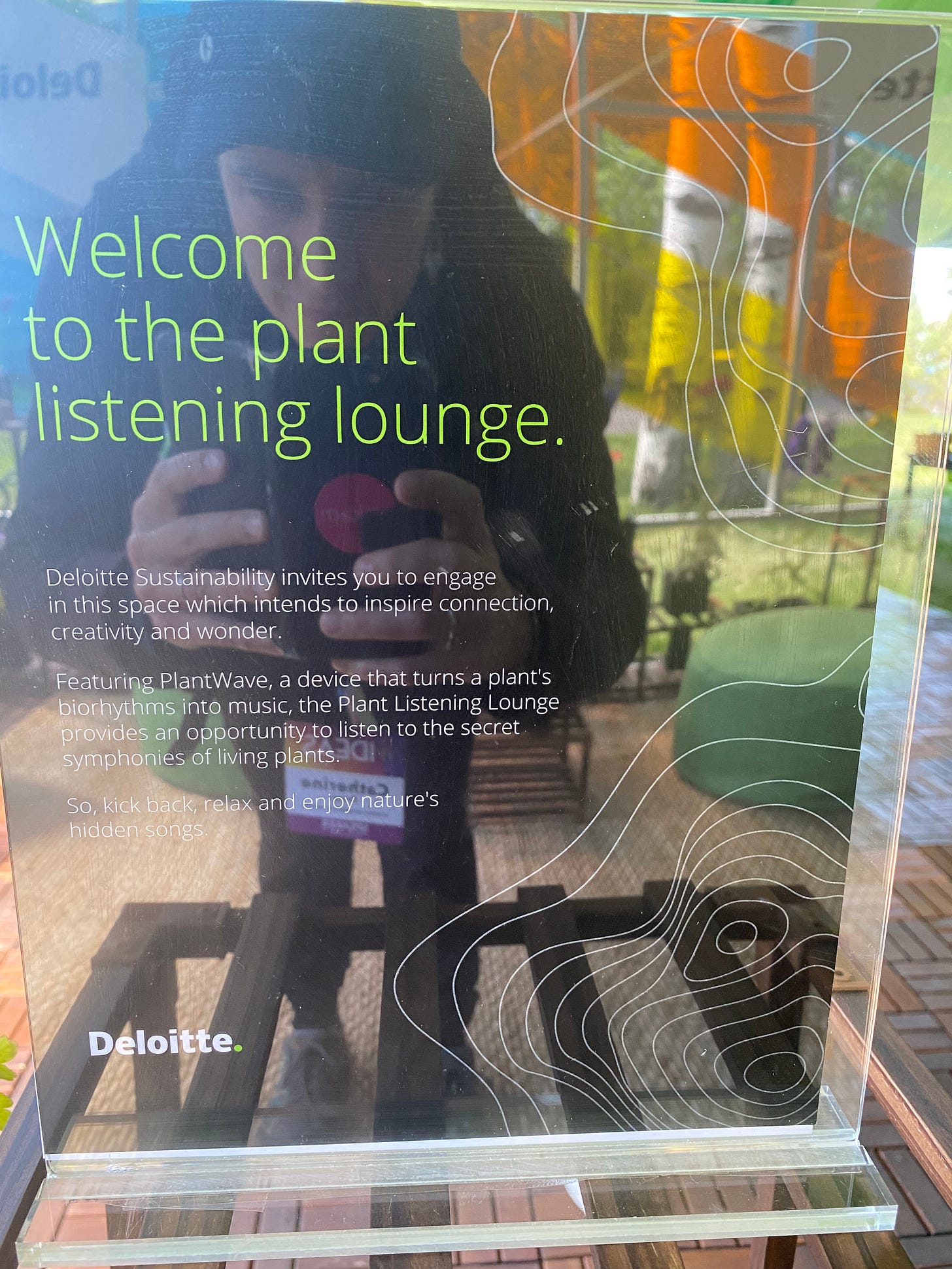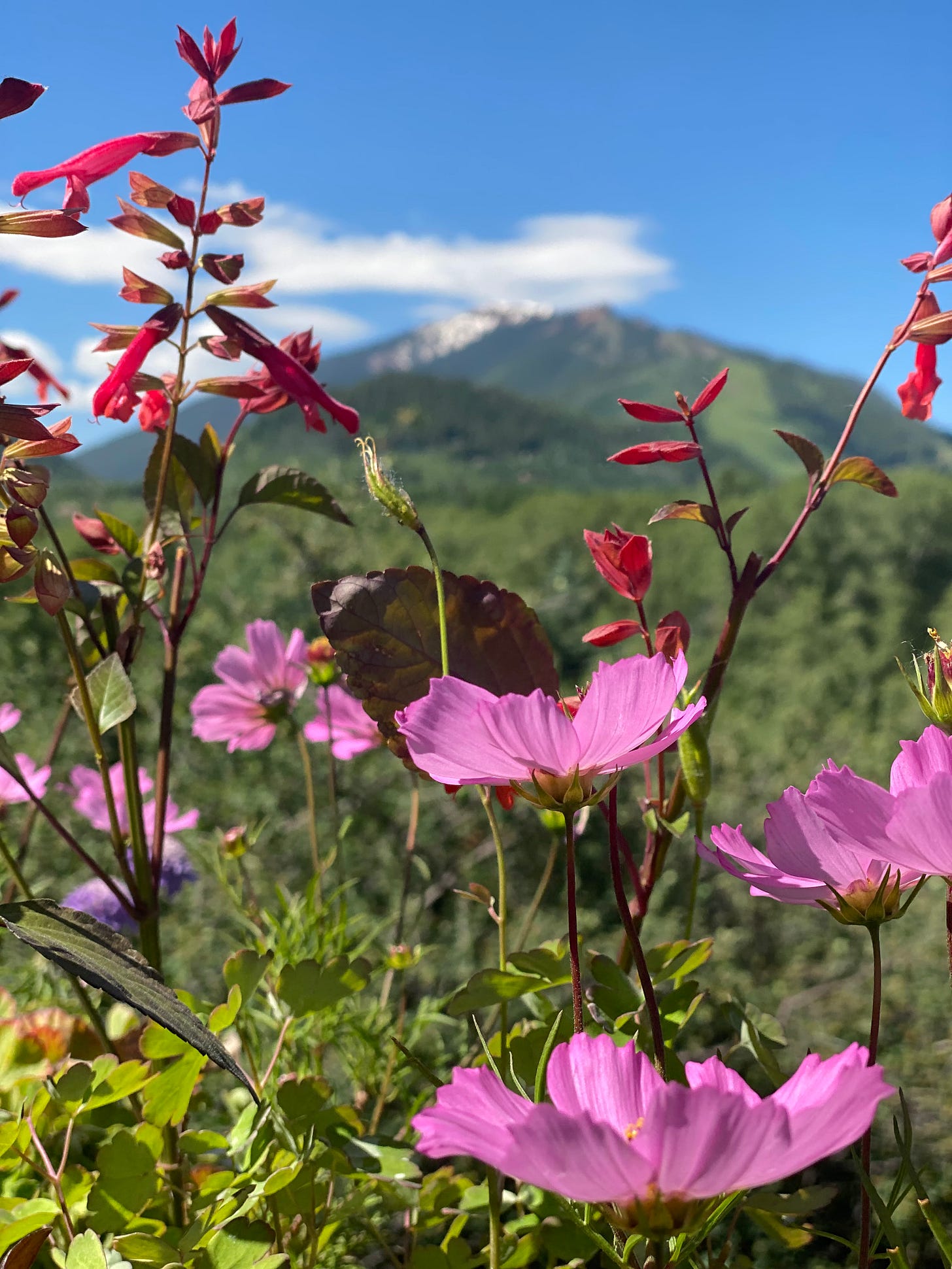The Surgeon General and the Healing Power of Love
Plus some other highlights and delights from the Aspen Ideas Festival
I recently had a chance to attend the Aspen Ideas Festival, where I gave a short keynote about fun and led a funtervention workshop, the highlight of which was undoubtedly when a woman who identified herself as a reverend told the entire audience about how much fun she’d recently had while playing with foam noodles during a naked pool party. (She, for the record, had been wearing a bikini.)
I attended a number of interesting sessions, including one about whether artificial intelligence (AI) will be able to help us communicate with animals, and another (co-led by Aza Raskin, who happened to be one of the speakers from the animal session) about AI’s looming threats. It was so intense that he and Tristan Harris, co-founders of the Center for Humane Technology, literally had the audience pause and take a collective deep breath.
I hope to write about that one in a future newsletter, but need to breathe a bit myself first—so for today, I wanted to share two more uplifting highlights.
First, I had the chance to attend a session featuring your favorite Surgeon General and mine, Vivek Murthy. He was being interviewed by NBC’s Andrea Mitchell about the importance of human connection, and the potentially detrimental effects of social media, particularly on kids.
Now normally, I’m pretty good at keeping track of conference schedules, but apparently not at this one, because shortly before it was scheduled to start, I decided to go to the gym. (It was my first morning there; I’m blaming the altitude.) It was only when I was on my way back to my room and noticed a crowd of people streaming into a building that I realized that his session was about to begin. (I mention this to explain why, in the photos below, I am unshowered, red-faced, and wearing spandex.)
Now, if you’ve read my past newsletters (or are able to interpret the body language in the above photograph), you already know that my appreciation for Dr. Murthy’s work runs deep. I had the chance to be a guest on his House Calls podcast, which then inspired me to read his fantastic book, Together: The Healing Power of Human Connection in a Sometimes Lonely World (more on that in a future newsletter, too).
I absolutely love the fact that he is calling attention to the physical effects of loneliness and isolation, and also empowering parents around the world to hit pause before allowing their children access to social media. (In case you missed them, here are his recent health advisories about the importance of social connection, and, separately, the potential harms of social media on kids.) So I was really excited to attend his session.
His conversation with Andrea Mitchell touched on both connection and social media, and is well worth watching. But there was one part that truly surprised me, especially considering that it was coming from “the Nation’s doctor,” who is tasked with “providing Americans with the best scientific information available on how to improve their health and reduce the risk of illness and injury.” (If you want to watch it, this part starts around minute 54 of the recording.)
It began when he asked us to call to mind three people from our lives: someone who had loved us over the course of our lives unconditionally, someone whom we ourselves had loved and cared for, and someone who was having a hard time right now and was struggling. (To really experience what this was like, you have to know what his voice sounds like—which is to say, smooth and calming; the man literally has guided meditations available online.)
He encouraged us to hold those people “in your head and in your heart for just a moment” — and paused. The room was silent; many of us closed our eyes. Then he explained:
“What those three people remind us of is that we have the capacity to be loved, we have the ability to give love, and that there is still great need for love in the world.”
“I mention this,” he continued, “because love is powerful. Love is healing. And there is no force I know, no medicine that I’ve written a prescription for, that is more powerful when it comes to healing. And the force of love and the fact that you have the ability to deliver it through your interactions with other people makes all of you healers. And so as you go out into the world and live the rest of your lives and think about how to shape and address what society looks like in the future, I want you to remember that you are healers — that all of us are healers. That we feel so much of the same pain, but we also can see what the world could look like if we only would allow ourselves to lead with love.”
I mean, COME ON, right? I definitely teared up — I never would have expected the Surgeon General of the United States to end his talk by expounding on the healing power of love. But . . . he’s right! And the world would be such a better place if we took his words to heart.
Other Delights:
The Bezos Scholars
I had the chance to be a guest speaker/mentor for the 2023 cohort of Bezos Scholars, a group of extraordinary 11th graders (and their chosen teachers) who are all so wonderfully energetic and passionate that it makes me feel optimistic about the future. Also, Brendan Salisbury — he’s the one in the tie — introduced me in a way that was so thoughtful and heartfelt that it made me tear up, to the point that they actually felt the need to hand me a box of tissues. (Apparently this was a theme for me.)
Musical Plants
Okay, this one doesn’t involve any tears.
At some point I was chatting with a fellow attendee who asked me if I had gone to the plant lounge yet to listen to the music. “The plant what?” I asked. She explained that there was an area in one of the tents where a bunch of plants had been connected to little devices that picked up on the plants’ electrical signals and translated them into music. “It’s very relaxing,” she assured me.
This sounded both strange and intriguing, so the next time I passed the tent, I made a point to stop by. Sure enough, there was a selection of plants arranged near a few couches and chairs, some with sensors clipped to their leaves and stems that connected them to a small wooden device that translated their “biorhythms,” as the informational placard described it, into music—or at least musical sounds.
Here’s the sign describing it:
Weird, right?
There was a young man sitting in one of the couches who looked kind of official, so I asked him what was going on. “Well, that plant over there is playing the keyboard sounds,” he said, gesturing toward a tall wispy fern-like plant. “And this one is doing vocals. And this one,” he gestured to the plant pictured below, “is playing bass.”
For some reason, I found the idea that this particular plant was the bass player to be completely delightful. I mean, look at it! Perhaps I’m plant-stereotyping, but I would have pegged this one as the windchime player; maybe the flute. But the bass?
Whatever instrument this plant was playing, the cumulative result was extremely reminiscent of spa music: gentle, soothing, without any sort of discernable beginning or end. It actually made me wonder whether this were a coincidence: do we find spa music relaxing because it’s somehow translating nature’s energy into sound? (Yes, I just got seriously woo woo there for a moment.) Or were the devices just set to make the electrical currents sound like spa music?
Curious, I then re-approached the young man to ask him whether the plants always played music that could accompany a massage. He said no.
“I’ve played around with different sounds, and it can get crazy,” he told me, with a laugh that made me wonder just what might happen if I were to visit the plant lounge after dark. Would it be a rave? A Metallica concert? Ed Sheeran? A bachata dance party? Unfortunately, the lounge closed before sundown, and the plants kept their late-nite music to themselves. . . .
Speaking of plants. . .
There were a lot of delightful ones, including this collection that I noticed in a planter that not only had this mountain as its backdrop, but also was frequented by hummingbirds.
And lastly . . .
The Delight of Delights
I had a meta delight: during my keynote, I had suggested that the Aspen Ideas attendees notice and share delights with each other (I even had them practice by collectively putting their fingers into the air and shouting, “Delight!”).
So you can imagine my delight when multiple people came up to me during the course of the week-long festival to share their own delights with me (often with a finger raised to the air). It seemed like a variation on the Surgeon General’s message: that the world would be improved if, instead of arguing with each other and doomscrolling the news, we made a point to focus on and share the small things that bring us joy.
To scrolling less and living more,
Catherine Price











